Tag Archive: EBP
June 17, 2013
by Carole Zangari -
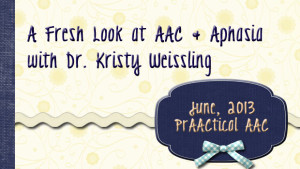
We’re so pleased to be able to share the thoughts of our friend and colleague, Dr. Kristy Weissling, on providing AAC supports to people with aphasia. She received her professional doctorate from Nova Southeastern University and is currently an Assistant Professor of Practice and clinical supervisor at the Barkley Speech-Language and Hearing Clinic at the University of Nebraska-Lincoln. Her research and teaching interests include, aphasia, cognitive communication impairments, and AAC. She participates in implementation of a portion of the RERC grant project at the University of Nebraska-Lincoln. She has been an instructor in aphasia and cognitive linguistic impairments for 15 years and teaches in both online and live formats. Her clinical load includes individual and group treatment of individuals with aphasia, traumatic brain injury, and early cognitive decline. In this post, Kristy reflects on three articles that have shaped her clinical services and teaching. :::::::::::::::::::::::::::::::::: I have been working with people who... [Read More...]
Filed under: PrAACtical Thinking
Tagged With: aphasia, EBP, Fresh Look, Kristy Weissling, research
June 11, 2013
by Carole Zangari -
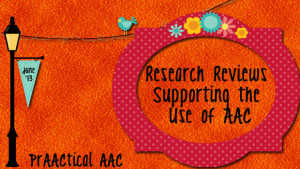
When recommending AAC, SLPs often find it useful to use research findings to support their clinical rationales. Sometimes we share articles with colleagues and families, or provide references in evaluation or consultation reports. In this post, we share a number of research reviews, studies which examined previously done research in AAC. Finding a relevant systematic is like hitting the jackpot, because the researchers have already done an exhaustive search of the literature on the topic, then analyzed the studies that met their criteria. Here are several research reviews that might come in handy during your AAC work. Ganz, J.B., Earles-Vollrath, T.L., Heath, A.K., Parker, R.I., Rispoli, M.J., & Duran, J.B. (2012). A meta-analysis of single case research studies on aided augmentative and alternative communication systems with individuals with autism spectrum disorders. Journal of Autism and Developmental Disorders, 42,1, 60-74. McCarthy, J., & Light, J. (2005). Attitudes toward individuals who use... [Read More...]
Filed under: PrAACtical Thinking
Tagged With: EBP, reference list, research, systematic review
April 28, 2013
by Carole Zangari -
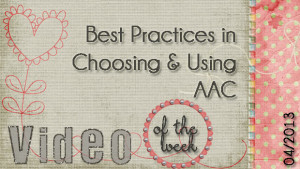
What better way to wrap up a busy month of Autism Awareness and Acceptance than by thinking about best practices? We’re please to be able to share a presentation from the 2012 Summer Institute on Neurodevelopmental Disorders at University of California at Davis MIND Institute. Enjoy “Best Practices in Choosing and Using AAC” by Kristen Carroll and Bonnie Mintun.
Filed under: Video of the Week
Tagged With: ASD, best practice, Bonnie Mintun, EBP, Kristen Carroll, MIND Institute
January 20, 2013
by Carole Zangari -

The research base for using video modeling as a tool to help AAC learners understand what to do is well-documented. The folks at SCAAC-N make it look easy! Here are a few that they shared for communicating while doing a job (shredding paper). Asking for ‘more’ Asking for a break Asking for help Want to know more about using video modeling in your own practice? Here’s a great resource document from the National Professional Development Center on ASD. Want more info on how to do this with mobile technology? Tony Gentry from Autism Center at Virginia Commonwealth University explains in this video.
Filed under: Video of the Week
Tagged With: EBP, mobile device, video modeling
October 26, 2012
by Carole Zangari -
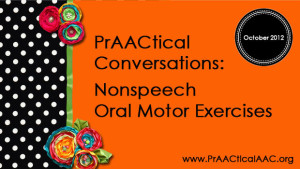
There are some good reasons to use nonspeech oral motor exercises, like blowing, puckering, tongue lateralization, and stretching. For a period of time, I used resistance exercises extensively with one client to improve the resting posture of his articulators and help him keep his mouth closed. Good for hygiene and to reduce his exposure to germs. Using these strategies, lots of children have gained strength and control that allowed them to better bite, chew, and swallow their food. Oral motor exercises can result in some meaningful gains. According to the research, however, improved speech articulation is not among them. There have been a number of studies on this approach, including some strong systematic reviews by McCauley and others. This summary by Dr. Greg Lof (Chair of the Department of Communication Sciences and Disorders at Massachusetts General Hospital Institute of Health Professions) is a few years old but is worth another... [Read More...]
Filed under: PrAACtical Thinking
Tagged With: controversy, EBP, evidence, nonspeech oral motor exercises, research, resources
May 18, 2012
by Carole Zangari -
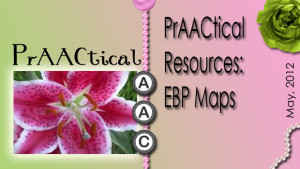
– –ASHA’s Center on Evidence-Based Practice (EBP) in Communication Disordersis beginning to have some relevant information for the AAC community. While many SLPs equate EBP with research and journal articles, this is only one component. ASHA’s EPB group is working with content area specialists to develop navigable evidence ‘maps’ to highlight information in each of the three pillars of EBP: Clinical Expertise/Expert Opinion, Research, and Client/Family Perspectives. – Professionals working with children and adults who have developmental disabilities may be interested in this Evidence Map on AAC and Cerebral Palsy. Additional evidence maps that have an AAC-related component been developed for dementia, TBI in adults, and autism.
Filed under: PrAACtical Thinking
Tagged With: client perspective, clinical expertise, EBP, research





